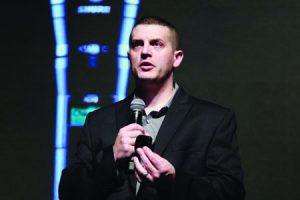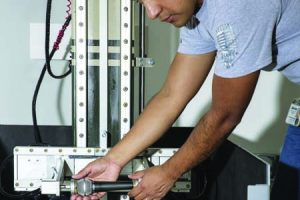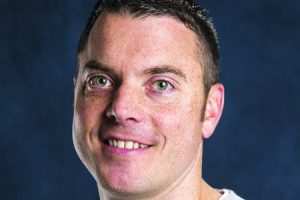BroadcastPro ME visited the Shure headquarters in Chicago recently and came back with a deeper understanding of what goes into the making of wireless systems.
 BroadcastPro ME visited the Shure headquarters in Chicago recently and came back with a deeper understanding of what goes into the making of wireless systems, and the new spectrum challenges manufacturers contend with.
BroadcastPro ME visited the Shure headquarters in Chicago recently and came back with a deeper understanding of what goes into the making of wireless systems, and the new spectrum challenges manufacturers contend with.
Late last year, Shure announced the launch of its Axient Digital wireless system, conceived in response to the mounting RF spectrum pressure in the market. What made this launch different from the many other releases that come into our inbox was the fact that we had the opportunity to take an intimate look at the behind-the-scenes action and the challenges the development team went through.
At the impressive and spacious Shure headquarters in Chicago, a seven-floor, 32,980sqm glass building, no photography is permitted. Thats understandable, since Shures US headquarters does not just serve as a traditional office setting but also houses its Research and Development department a number of torture labs with various testing devices to put the companys mics, cables and other components through various endurance measures before they finally pass the quality test and make it to the end user. These rigorous testing centres include automated dropping of the mics, sweat testing, continuous cable yanking and a special team that even conjures up new forms of torture to test products.
The tour of the facility included a walk through a hall exhibit showcasing the origins and milestones of the company when Mr and Mrs Shure first began their journey, the evolution of Shure mics in their various avatars over the years, and posters of musicians who use these devices. By the end of the two-day trip, we came back with a new-found respect for wireless devices, especially microphones, and a deeper understanding of the many challenges manufacturers face with the diminishing RF spectrum in the market.

Shure President and CEO Christine Schyvinck, who delivered the welcome address, started off as an engineer and has been with the company for more than 28 years. The agenda included the announcement of the launch of the Axient Digital Wireless System.
We were at the facility, however, to gain a deeper understanding of the meticulous planning and extensive R&D that goes into developing a product before it finally comes to life. The new launch, developed from scratch, has been six years in the making, experts confided.
We spent almost three years just assessing and developing the technologies, because these products were built from scratch and lay the foundations for a whole new portfolio, commented John Born, Product Manager, Wired Microphones Shure Incorporated.
Starting from scratch is sometimes a necessary evil. Its a help and a hindrance, but being in a nice established company has meant that we also have the support of the management and the resources to extend a development for seven years, although we didnt plan for it to go on that long John Born, Product Manager, Wired Microphones Shure Incorporated
Starting from scratch is sometimes a necessary evil. Its a help and a hindrance, but being in a nice established company has meant that we also have the support of the management and the resources to extend a development for seven years, although we didnt plan for it to go on that long.
The next three years were spent developing the product itself, optimising the design and putting it through rigorous testing measures, and then beta testing with high-profile end users who use the product in some of the most challenging conditions before it actually sees the light of day.
There is no better example than the launch of Axient Digital to demonstrate this.

Michael Johns, Product Manager with Shure Incorporated, commented that Axient Digital was born of the demand for wireless.
All over the world, wireless spectrum is changing rapidly. We have gone through two massive instances of the repurposing of the UHF spectrum in the US and a lot of UHF reallocations have happened in the UK, Japan and across the world. Because of that, this wide band of RF spectrum that we could previously use to operate wireless microphones on has become reduced, because they have been sold off to telecom players and manufacturers for the most part, so there is less spectrum for companies like us to operate with.
The challenge is that theres going to be less … RF spectrum available, and we have tried to address this by creating technology solutions with high density mode. With the flexibility of digital and being able to change the parameters in the modulation scheme, we are able to accommodate more frequencies Michael Johns, Product Manager, Shure Incorporated
We, therefore, had to develop a wireless system that is very linear and spectrally efficient so we are not occupying more space than we need to. This allows you to keep away from interferences and get more channels on air at the same time. Stability is another big element in a wireless device. Wireless mics are used more and more on stages across the world it was important to develop rock-solid wireless systems, because any artist or musician doesnt expect a wireless mic to sound any different from a wired mic and they dont expect to have any drop-outs either, he explained.

Ten years ago, when Shure started its wireless journey, it became cognisant of the need to put together an engineering team that understood the various nuances of developing wireless technology.
Almost ten years ago, we assembled a whole engineering team that could do digital wireless, and that includes me and several others here who have assisted with the development. This new engineering team took up the challenge of making this; and what we have here today as a result is Axient Digital, a combination of new technology with several form factors and features that we have identified and implemented, based on feedback from users and customers, to create a full package, Johns said.
At its core, Axient Digital features a receiver compatible with its two transmitter offerings, the AD Series and ADX Series. Axient Digital with AD Series transmitters promises a high level of core product benefits, including exceptional RF performance, digital audio and networking. ADX Series transmitters also incorporate ShowLink, which provides real-time control of all transmitter parameters with interference detection and avoidance, and include the first micro-bodypack with an integrated self-tuning antenna, enabling greater concealment and comfort.
These are the key benefits. It was paramount to us to have a digital radio that could be very robust in the presence of high interference, commented Johns.

But lofty claims are nothing if they cant be seen in action, and we had the opportunity to do so the next day at the huge 61,500-seat Soldier Field American football stadium, with listening tests from various positions. This included testing the clarity of sound from a mic in the underbelly of the stadium, shut off from the rest of the world by a metre-wide concrete wall; and from the farthest corner of the stadium.
Shure delivered on its claim of maximum signal stability.
Audio quality is very important. We have used a digital architecture that provides a digital transport mechanism that sounds just like a wire, commented Johns, speaking about Shures patented Quadversity receiver technology, which significantly mitigates the potential for signal fades or interference that can cause dropouts.
Quadversity mode allows users to place sets of diversity antennas in different zones, or double the number of antennas in a single zone, to improve RF signal-to-noise in challenging environments. High density mode increases the maximum simultaneous system channel count from 17 to 47 per 6MHz TV band (from 23 to 63 per 8MHz TV band), while maintaining exceptional audio quality, he explained.
In terms of audio quality, Axient Digital has a 20Hz-20kHz range with a flat frequency response and accurate transient response. It also boasts wide dynamic range, AES-256 encryption and 2ms latency from the mic transducer to the analogue output.
Johns pointed out that the wireless system includes new Shure features named Dante Cue and Dante Browse, which seem to be associated in the industry with great flexibility to control output and high-fidelity headphone monitoring of audio output from any Dante-enabled connected device. A Shure-developed iPhone app, ShurePlus Channels, can also be used to control and command the wireless system.
One of the things the team has had to keep in mind is the ability of this system to talk to other systems.
Its very important for customers to be able to mix and match these products with other AD or ADX components. With Axient Digital, we wanted them to be able to leverage their existing investment and use our products, said Johns.
We also had the opportunity to have in the room a whole mix of experts at one time, who worked with the development team. This included experts who worked closely with very high-profile sports organisations for broadcast and those who have worked with some of the worlds best musicians in order to produce the quality of sound they are looking for.
Speaking about the challenges the market will face in the future, the Shure team pointed out that with frequencies being less available, priorities are changing for those allocating them, especially the hierarchy of who has access to the frequencies. Thats the first glimpse of the impact and how it could change our workflow, said Johns.
The challenge is that theres going to be less and less RF spectrum available, and we have tried to address this by creating technology solutions with high density mode. With the flexibility of digital and being able to change the parameters in the modulation scheme, we are able to accommodate more frequencies. This has been specifically addressed with the Axient Digital launch.
With wireless, our strategy is to keep pushing the envelope with regard to spectrum, efficiency and diversity. We have looked at alternative spectrums taking the same product and same benefits, and checked how to provide the same experience.
















































































